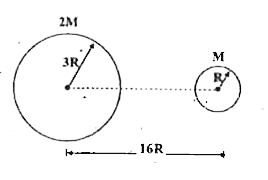Two spherical bodies of masses M and 5M and radii R and 2R are released in free space with initial separation between their centres equal to 12 R. If they attract each other due to gravitational force only, then the distance covered by the smaller body before collision is
2.5 R
5 R
7.5 R
10 R
The correct Answer is:C
Step by step video solution for Two spherical bodies of masses M and 5M and radii R and 2R are released in free space with initial separation between their centres equal to 12 R. If they attract each other due to gravitational force only, then the distance covered by the smaller body before collision is by Physics experts to help you in doubts & scoring excellent marks in Class 11 exams.
Similar Questions
Two spherical bodies of mass M and 5M & radii R & 2R respectively are released in free space with initial separation between their centres equal to 12R. If they attract each other due to gravitational force only, then the distance covered by the smallar body just before collision is
View SolutionTwo spherical bodies of masses m and 5m and radii R and 2R respectively, are released in free space with initial separation between their centres equal to 12 R. If they attract each other due to gravitational force only, the distance covered by smaller sphere just before collision is
View Solution
Knowledge Check
- Question 1 - Select One
Two spheres each of mass M and radius R are separated by a distance of r. The gravitational potential at the midpoint of the line joining the centres of the spheres is
A−GMrB−2GMrC−GM2rD−4GMr
Two spherical bodies of masses m and 6m and radii R and 2R respectively are released in free space with initial separation between their centres equal to 10 R . If they attract each other due to gravitational force only , then the distance covered by smaller sphere just before collisions will be
View SolutionTwo spherical bodies of masses 2M and M and radii 3R and R respectively are held at a distance 16R from each other in free space. When they are released they start approaching each other due to the gravitational force of attraction , then find
(a) the ratio of their accelerations during their motion
(b) their velocitites at the time of impact.
 View Solution
View SolutionTwo spherical balls of mass 10 kg each are placed 100 m apart. Find the gravitational force of attraction between them.
View SolutionTwo spheres each of mass M and radius R are separated by a distance of r. The gravitational potential at the midpoint of the line joining the centres of the spheres is
View SolutionTwo objects of masses m and 4m are at rest at an infinite separation. They move towards each other under mutual gravitational attraction. If G is the universal gravitaitonal constant, then at separation r
View SolutionTwo bodies with masses M1 and M2 are initially at rest and a distance R apart. Then they move directly towards one another under the influence of their mutual gravitational attraction. What is the ratio of the distances travelled by M1 to the distance travelled by M2?
View SolutionTwo bodies with masses M1 and M2 are initially at rest and a distance R apart. Then they move directly towards one another under the influence of their mutual gravitational attraction. What is the ratio of the distances travelled by M1 to the distance travelled by M2?
View Solution
